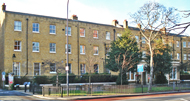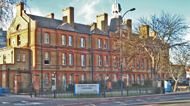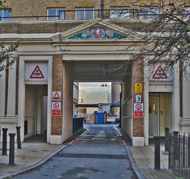Acute
The current Hospital was originally the Lewisham workhouse, which opened in 1817. Its main frontage ran along Lewisham High Street, with a long east-west wing to the rear. It could house 186 inmates.
In 1837 the Board of Guardians of the newly formed Lewisham Union decided that the capacity of the workhouse was inadequate for the new Union. At the cost of £2000 the building was enlarged to accommodate 300 paupers. Cholera wards were built behind the workhouse.
By 1865, according to a report in the Lancet, although not overcrowded (only 180 inmates had been noted), the workhouse had essentially become a pauper hospital for the elderly, sick and infirm (no able-bodied persons were observed). There were 72 beds in seven 'sick wards' (three for males and four for females) and 22 beds in four 'infection wards'. The Lancet noted that the iron bedsteads were only 5ft (1.5 m) long and 2ft 5 in (0.75 m) wide.
In 1892 building work began to construct a separate infirmary to the north of the workhouse, and this was formally opened in 1894. Almost as soon as it opened there was friction between the Matron, who had trained at St Thomas' Hospital, and the Medical Superintendent. The Infirmary Committee of the Board of Guardians were compelled to investigate the matter. They concluded that Matron had been insubordinate, as by old Standing Regulations in Poor Law infirmaries her post was subordinate entirely to that of the Medical Superintendent. The Matron appealed to the Local Government Board and refused to resign her post until an inquiry had been held. The affair rumbled on in the nursing press for some years.
Medical staff quarters were built in 1895. In 1897 the infirmary began to accept 'lunatics' and, by the turn of the century, enjoyed a good reputation as a well-run establishment.
From 1904, to spare them the stigma of having been born in a workhouse, newborn babies were issued with birth certificates giving only the street address of the workhouse - 390 High Street Lewisham.
During WW1 most of the workhouse inmates were transferred elsewhere and the site became the Lewisham Military Hospital. It had 24 beds for officers and 838 for servicemen. Some 190 beds were for German prisoners-of-war, including 12 for ordinary cases and 12 for insane officers.
In 1925 the buildings were extended and, in 1927, a new, larger Nurses' Home was built at a cost of £126,000. The workhouse continued functioning to a small degree after the war until 1929, when the Boards of Guardians were dissolved. The site was taken over by the LCC and became a general hospital under the name of Lewisham Hospital.
In 1932 work began on a new ward block consisting of three wings to house a maternity department with 63 beds, a children's section with 35 cots and two general wards with 66 beds. The new extension, which had cost £55,500 (including equipment), was the largest piece of construction work undertaken by the LCC since it took over responsibility for municipal hospitals. It was officially opened in October 1934 by Lord Dawson of Penn, the President of the Royal College of Physicians of London. The Hospital then had 747 beds.
In 1935 Princess Marina opened a further new wing. It had cost £24,000.
During WW2, in July 1944 a V1 flying bomb destroyed two wards, the Registrar's office and the library. One nurse was killed and a further 70 patients and staff injured, three of whom later died of their injuries.
In 1948 the Hospital joined the NHS as the Lewisham Hospital Group, under the control of the South East Metropolitan Regional Hospital Board. At this time the average length of stay at the Hospital was 20 days.
In 1954 a Premature Baby Unit opened with 12 cots. In 1956 Mr R. Owen, Chairman of the Hospital Management Committee, laid the foundation stone for a new Out-Patients Department, to be built on the site of the bombed ward block. In 1957 a staff paging system was installed, the second such in a hospital in the United Kingdom.
In December 1957 a train crash occurred just outside St John's railway station. The casualties were taken to Lewisham Hospital, St John's Hospital and Grove Park Hospital. Ninety two people were killed and 173 injured.
In 1958 the completed Out-Patients building was officially opened by Princess Margaret.
In 1964 the Accident & Emergency Department was extended to give extra consulting rooms and a new, larger X-ray Department. In 1966, as the second phase of the development of the Out-Patients building, operating theatres and a new pharmacy were opened. In 1969 an Antenatal Clinic, a new Special Care Baby Unit (replacing the Premature Baby Unit opened in 1954), and an Intensive Therapy Unit (the first in a District General Hospital in England) were officially opened by Mr. Julian Snow, the Parliamentary Secretary to the Minister of Health. The three Units had cost £126,000.
In November 1967 another major train crash occurred at Hither Green station, with 53 killed and 90 injured. The casualties were taken to Hither Green Hospital and to the Lewisham Hospital.
In September 1968 there was severe flooding in the south east of England, with Lewisham particularly affected. The High Street was the worst hit; repairs to the badly damaged Nurses' Home cost £10,000.
In 1970 a Regional Centre for the Blood Transfusion Service was established. In 1971 a new Nurses' Education Centre opened at the cost of £150,000. In 1974, following a reorganisation of the NHS, the Lewisham Hospital Group became one of the four Health Districts in the Lambeth, Southwark and Lewisham Area Health Authority (Teaching) - the others were King's College Hospital, Guy's Hospital and St Thomas's Hospital.
In June 1972 a third rail crash occurred at Eltham. Six people died, including the driver, and 126 were injured. Some 24 casualties were brought to Lewisham, as the 'supporting' hospital.
In another reorganisation in 1982 the Hospital became part of the Lewisham and North Southwark District Health Authority.
In 1987 phase 1 of a £10m redevelopment was completed. It comprised four new operating theatres, a surgical ward, new rehabilitation facilities, a kitchen and a dining room, and a boiler house. The Accident & Emergency and Out-Patients Departments were also refurbished.
In 1990 the Hospital had 557 beds. In 1991 services were transferred from the Children's Hospital in Sydenham when it closed. In 1992 a CT scanner was purchased with funds raised by the Scanner Appeal, which had begun in 1989.
In 1993, following yet another NHS reorganisation, the Lewisham Hospital NHS Trust was established. Dunoran Home, which had opened in 1945 as a home for the chronically ill, became part of the Trust. The second phase of the redevelopment of the Hospital, which would include a new Women's and Children's Wing and cost £35m, began. In 1994 Sapphire Ward, a 20-bedded surgical ward, opened and also later a Day Surgical Unit. In 1995 the Accident & Emergency Department was upgraded and extended as a cost of £1m. In October of the same year an Emergency Referral Unit for GPs to send emergency admissions to the Hospital opened. In November 1996 Princess Alexandra officially opened the new Women's and Children's Wing. In 1997 services for care of the elderly transferred from Hither Green Hospital when it closed. In the same year the Trust was awarded formal status as a university Hospital and its name was changed from Lewisham Hospital to University Hospital Lewisham. A new main entrance opened. In 1998 the Ladywell Unit, to provide mental health care, was officially opened by Mr Frank Dobson, Secretary of State for Health.
In 2002 phase 3 of the redevelopment commenced, at the cost of £58m, to replace the old style Nightingale wards with multiple four-bedded bays. In November 2006 the new Riverside Building, housing the adult and elderly wards, was completed. It was officially opened in May 2007 by the former Archbishop of Cape Town and activist against apartheid, Desmond Tutu. The new building, with photovoltaic panels installed on its roof, is the first NHS building to generate a proportion of the energy needed to run it.
Present status (January 2008)
Most of the original buildings have been demolished and replaced, but a few survive.
The workhouse building fronting Lewisham High Street is now known as the Waterloo building and houses various offices and meeting rooms and the Pathology Department. The medical staff quarters, built in 1895, have become the Children's Out-Patients Department.
The Hospital has expanded and upgraded many services since it joined the NHS, but in 2008 closure was threatened of its Accident & Emergency Department, the Maternity Unit and the Children's Hospital in a review of healthcare provision in southeast London, entitled A Picture of Health. For the moment at least the services remain.
At the north of the site is the Ladywell Unit, operated by the South London and Maudsley NHS Foundation Trust, providing mental health care.

The original workhouse building along Lewisham High Street, built in 1817, is now called the Waterloo block.

The building for medical staff accommodation, built in 1895, is now the Children's Out-Patients Department.


The original entrance to the workhouse with the logo of the Lewisham Union above the doorway.

The Lewisham Union logo.
The new Riverside Building, officially opened in 2007, built as a PFI-project valued at £70m.
(Author unstated) 1894 Editorial. The Lewisham Infirmary. The Nursing Record and Hospital World (November 24th), 337-338.
(Author unstated) 1900 Nursing echoes. The Nursing Record and Hospital World (September 22nd), 237.
(Author unstated) 1917 List of the various hospitals treating military cases in the United Kingdom. London, H.M.S.O.
(Author unstated) 1934 Lewisham Hospital extension. British Medical Journal 2 (3849), 684.
(Author unstated) 1998 A Rich Past...An Exciting Future. London, The Lewisham Hospital NHS Trust.
Mollett M 1899 The balance of power in hospital administration. The Nursing Record and Hospital World (April 12th), 125-128.
http://lewishamwarmemorials.wikidot.com
http://wapedia.mobi
www.aim25.ac.uk
www.kcl.ac.uk
www.lewisham.nhs.uk
www.london-footprints.co.uk
www.shine-network.org.uk
www.sydenham.org.uk
www.workhouses.org.uk
Return to home page